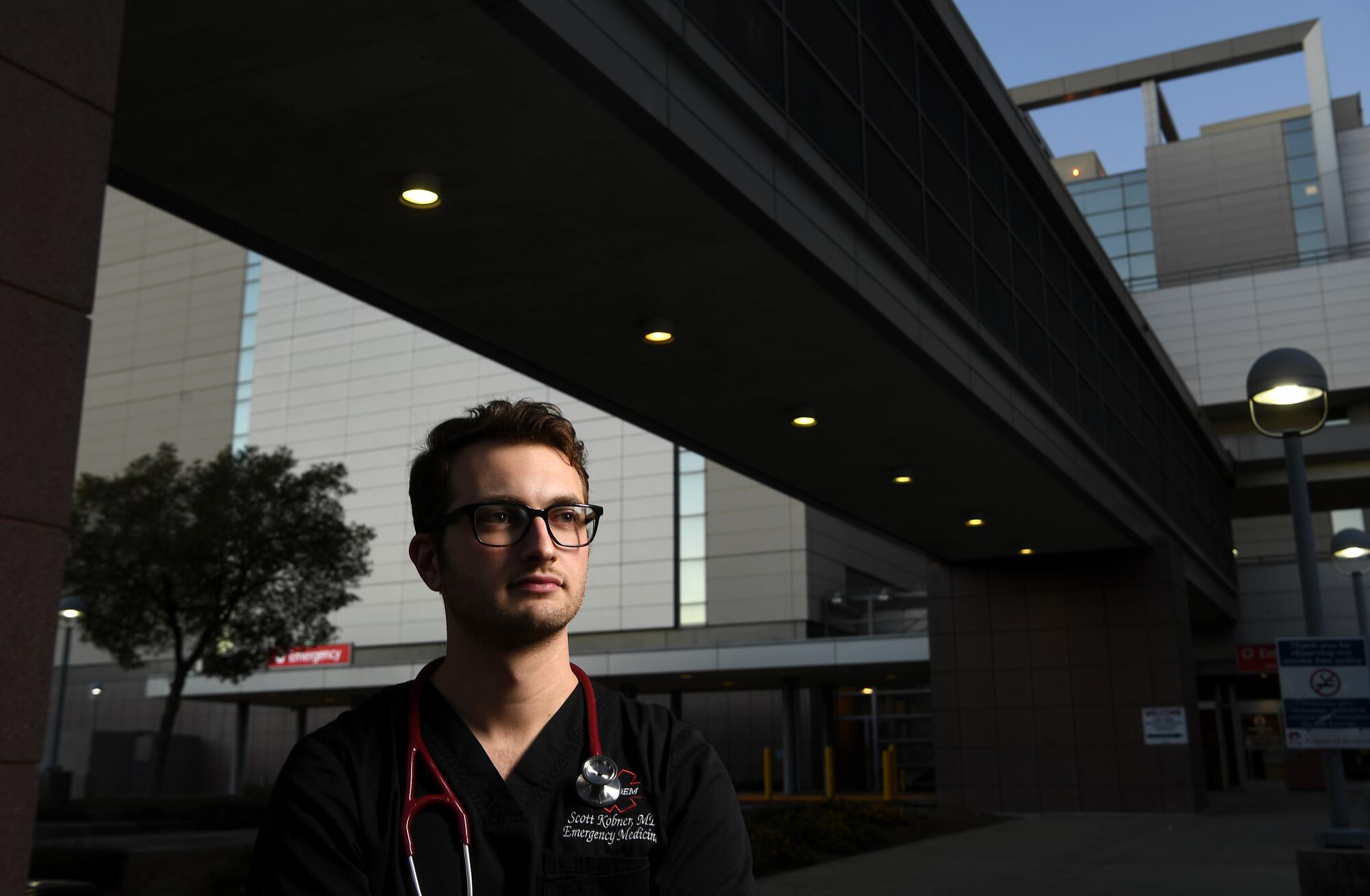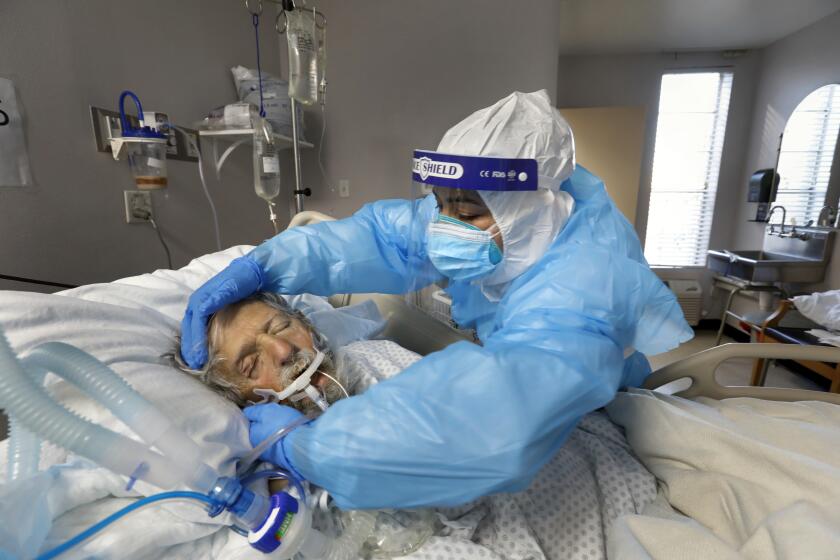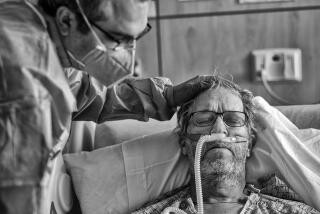- Share via
From behind her face shield, the young doctor stares straight ahead.
She stands behind a COVID-19 patient lying supine on an operating table. A vitals monitor shows the man’s heart is pounding and that he’s taking 47 breaths per minute — quadruple the normal rate. A nurse’s gloved hand reaches over him, clutching a syringe.
In the black-and-white photograph, the doctor’s eyes are wide.
The person who captured the moment didn’t have to ask why.

Dr. Scott Kobner, the 29-year-old chief resident at the Los Angeles County-USC Medical Center’s Department of Emergency Medicine, knew this was the moment of quiet just before a soon-to-be-intubated patient was put into a medically induced coma from which he might not wake up.
When the COVID-19 pandemic began last spring, devastating Kobner’s home state of New York before surging in California, he knew history was unfolding. Soon he began showing up at the hospital on his days off with instruments that, in the growing moment, felt as vital as his stethoscope: his Leica M6 and M10 cameras.
Witnessing so much pain over the last year from the COVID-19 pandemic will likely take a major toll on healthcare workers’ mental health, experts say.
Medical photography has a storied tradition that dates to the Civil War, when doctors captured black-and-white images of bullet wounds and gangrene and severed limbs that showed, in unflinching detail, the brutality of war.
Clinical photos from World War I that showed parts of soldiers’ faces blown off by machine guns became invaluable for surgeons learning how to literally reconstruct faces. These days, documentary-style photographs of the 1918 flu pandemic — the first major outbreak of which was at an Army base in Kansas in the midst of the war — are treasures in the age of COVID-19.
The pandemic is not a conventional war, but in its own way it is combat, with its variety of foot soldiers — doctors, nurses, first responders — and a front line that shifts, in intensity and dimension, hope and despair, as much as a battlefield.
Kobner was determined to document it at County-USC, one of the nation’s largest public health systems.
“There’s a narrative authority of photography,” he said. “People just undeniably accept a photo as a moment of reality that we have to interpret. ... There’s a lot of delicacy that’s involved in taking these types of photographs, and you have to have the utmost respect for the human dignity and the condition of the people involved.”
Dr. Daria Osipchuk was taken aback when she first saw Kobner’s photo of her wide eyes, the only part of her face visible above her N95 mask. She had never seen a photograph of herself working.
“It was a little haunting looking into my own eyes and seeing — in my eyes, I’m seeing that moment of calm right before the intubation and the gravity of the situation,” said Osipchuk, a 29-year-old resident.
Medical illustration has been used as a teaching tool for hundreds of years. But the use of photography to document human crises proliferated during the Civil War, especially after the Army Medical Museum was founded in 1862 to collect artifacts and images for research in battlefield medicine.
Once nurses enter the COVID-19 ward, they often feel as isolated as their patients.
A prolific contributor of photographs to the museum was Dr. Reed Bontecou, a New Yorker who became surgeon in charge at Harewood Hospital in Washington, D.C.
He took portraits of wounded soldiers and, as a teaching tool, marked them with a red pencil to show bullets’ trajectories. Veterans later used the photos to prove the severity of their injuries while applying for government pensions.
Bontecou took close-ups of gangrenous wounds and documented the use of anesthesia. One of his images, titled “Field Day,” shows a stack of amputated feet and legs outside the hospital just before they were burned, said Mike Rhode, an archivist for the U.S. Navy Bureau of Medicine and Surgery.
Doctors’ photographs have been useful both for documenting human tragedy and for clinical use, showing physicians what kinds of wounds they might be treating.
“It’s not just a professional photographer looking for some gory story; it’s an insider’s perspective,” said Jim Connor, a professor of medical humanities and the history of medicine at Memorial University of Newfoundland.
“It’s giving an insight to the general public — this thing is real. ... It gives it a level of veracity and truthfulness having the physician or nurse take the photos.”
Kobner, the son of two police officers, said he was always drawn to public service. Emergency medicine — which he describes as “the intersection of human conditions: socioeconomics, the terrible circumstances of our biology, the things we can’t control as human beings” — fit the bill. He studied at New York University, and is living his dream as a resident at County-USC, the 600-bed public hospital in Boyle Heights.
When New York became an early epicenter of the pandemic last spring, Kobner recognized the doctors on the news as hospitals were inundated with coronavirus cases. They were his friends and medical school instructors, the people who taught him how to use a ventilator.
Kobner felt guilty. Cases had not yet exploded in Southern California, and his hospital had time to prepare. The emergency room at County-USC was eerily empty as people stayed home and avoided hospitals.
“It was very creepy for all of us,” Kobner said. “We had never heard the silence of our hospital at that point.”
The first surge came early last summer. That’s when Kobner treated his first very ill COVID-19 patient. He still thinks about her a lot.
She was a sweet woman in her 50s, with wavy brown hair and a big smile. She had a high fever and was drenched in sweat but joked that Kobner must be hotter than her beneath all of his personal protective equipment.
She came at the beginning of a busy shift in the emergency room and declined quickly. Intubation was her last option, even if it wasn’t a good one, Kobner said.
It was the first time Kobner had to prepare a family to talk to a loved one over FaceTime before intubation, the first time he had to say it might be the last chance they get to speak to them.
The woman’s daughter asked Kobner what she should say. He told her what he would say to his mom or dad or sister: that he really loved them, that he was sorry he couldn’t be there, but that he was just on the other side of the phone. He would tell them how happy they made him.
When the medical team was preparing to intubate her, all of them had tears in their eyes.
“You’re in a full mask and gown,” Kobner said. “You can’t wash those away. They’re just hanging there. I think about her a lot because it hasn’t gotten any easier hundreds of conversations later.”
The woman died.
Kobner takes photographs only on his days off and makes it clear to patients that he’s not involved in their care. The hospital, he said, gave him permission to take photos because of the historic nature of the pandemic, and he gets consent from each patient.
Kobner said he felt a duty to pick up his camera because so much suffering from the pandemic was happening behind hospital walls, largely out of view of a public that has an easier time disbelieving what it can’t see.
“I think acknowledging the humanity and the true human struggle that is what we do every single day has a much more profound impact than a campaign that has really fancy graphics or a powerful testimony,” he said.
Over the summer, Kobner tested positive for the coronavirus and was sick for about 10 days, confined to bed for much of that time. He lives alone — a blessing and a curse in isolating times like these. He felt fortunate he didn’t have to be hospitalized.
But he said the winter surge was worse. There was a feeling of helplessness for weeks on end. No matter how many patients he saw during a shift, he knew he would see just as many the next day.
“In emergency medicine, we’re used to seeing so many varied complaints: heart attack, gunshot wound, broken arm,” he said. “But during the surge, it was the same story over and over and over again.”
In December, he started posting some of the photos to Instagram with captions that are clinical, melancholic, frustrated, hopeful.
There’s a photo of a woman lying on her stomach in her hospital bed, a tube in her nose. Her eyes are sad.
“Isolation, quarantine, loneliness: words now included in our daily vocabulary. ... When Ms. H told me how alone she felt, at home before getting sick and now fighting COVID in the hospital, I could only share a dream of a better future with her,” he wrote. “Getting back to a time when I could hold her hand as we spoke without a latex glove or a plastic gown separating us from human touch.”
In another darkly lighted shot, a doctor stoops over a patient’s head, holding a pair of suture scissors after drilling a hole in the woman’s skull.
“Strokes and intracranial bleeds are potentially devastating complications from this infection that are heartbreaking to witness,” Kobner wrote. “A drain placed into the brain through the skull relieves the build up of pressure that accompanies intracranial bleeding, and emergent drain placement can be life saving for patients.”
Another shows a wall just outside the COVID-19 unit, where Polaroid self-portraits of smiling doctors and nurses hang next to boxes of gloves and masks. They had taped the photos to their gowns to show patients what they looked like beneath the goggles and face coverings.
The ritual, he said, declined as the appearance of personal protective equipment became normal.
“Some of these faces I haven’t seen without a mask in months,” he wrote. “Their smiles seem so genuine and full of life — eager and hopeful. They look so different than the eyes I see daily: full of fear, fatigue and sorrow.
“These photos were for the patients, but now I think they are for us.”
More to Read
Sign up for Essential California
The most important California stories and recommendations in your inbox every morning.
You may occasionally receive promotional content from the Los Angeles Times.













